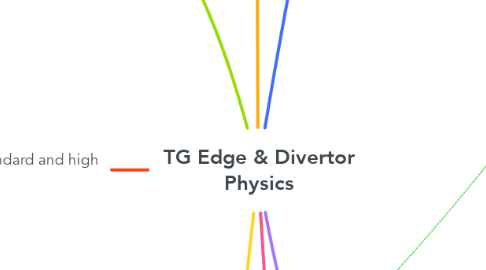
1. Power exhaust
1.1. Heat transport regimes
1.1.1. Conductive vs convective, needs EMC3-Eirene (only std,LI andHM)
1.2. Relation of particle and heat fluxes
1.3. Wetted area
1.3.1. What happens above PSOL > 5 MW?
1.3.1.1. standard
1.3.1.2. high iota
1.3.1.3. high mirror
1.4. Control of divertor loads
1.4.1. Effect of iota modification with planar coils (Lazerson)
1.4.2. Effect of inward-outward shifting with planar coils (Lazerson)
1.4.3. Effect of island size & phase with control coils
1.4.4. ECCD
1.4.5. Development of safe plasma scenarios
1.4.6. Investigation of fast ion divertor loads (Lazerson)
1.4.7. Safe scenarios for divertor middle part
2. SOL transport and profile
2.1. perpendicular to B/turbulent
2.1.1. heat
2.1.1.1. relation to wetted area and SOL thickness
2.1.2. particles
2.1.2.1. quantitative assessment, diffusive vs convective character
2.1.2.1.1. assessment of D coefficient for modelling
2.1.3. heat and particles
2.1.3.1. role of magnetic topology/island geometry
2.1.3.2. role of filaments, Er in the islands
2.1.3.3. drifts on edge radiation distribution, particle flows, heat deposition pattern
2.1.3.3.1. drift mechanisms
2.1.3.3.2. drifts in different magnetic configurations (again low iota? standard, high mirror)
2.1.3.4. role of NBI
2.1.4. scenario
2.1.4.1. SOL turbulence in detachment
2.1.4.2. SOL turbulence in (post) improved confinement phases
2.1.4.3. SOL turbulence vs target heat loads. Common dependence on operation parameters? Possibility to control heat load pattern?
2.2. Parallel to B
2.2.1. heat
2.2.1.1. strike lines location
2.2.2. particles
2.2.2.1. flow behaviour
2.2.2.1.1. main ion measurements in island chain in He plasmas
2.2.2.2. impurity transport
2.2.3. heat and particles
2.2.3.1. sheath-limited vs conduction-limited regimes
2.2.3.1.1. effect of radiation location (different SOL locations+inside LCFS)
2.2.3.1.2. ionisation sources within the SOL
2.2.3.1.3. role of magnetic topology/island geometry
2.2.3.1.4. role of NBI
2.2.3.1.5. parameters scan for database as reference for modelling
2.2.3.2. validation of extended 2 point model and EMC3-Eirene comparisons
2.2.3.2.1. "upstream" definition with comparisons of different diagnostics
2.2.3.2.2. "downstream" validation with comparisons of different diagnostics
2.2.3.2.3. effect of control coils
2.3. Profiles
2.3.1. heat and particles
2.3.1.1. density profiles
2.3.1.2. temperature profiles
3. Dynamic effects in island divertor
3.1. Plasma beta
3.1.1. Test predictions
3.1.2. High beta scenarios
3.2. Effects of toroidal currents on SOL
3.2.1. High current scenarios
3.3. Island/divertor mode dynamics
3.3.1. Currents in SOL (Lazerson, Wurden, Andreeva)
3.3.2. Island localized mode activity (Andreeva, Wurden, Lazerson)
3.3.3. Thermoelectric current?
3.3.4. non-thermal directed electron currents (Liu, Liao)
4. Error field correction in standard and high mirror at reversed field
5. Detachment
5.1. Detachment in other configurations
5.1.1. High iota
5.1.2. High mirror
5.1.3. Configuration/iota scan
5.2. Upstream density threshold for detachment
5.2.1. Pellets
5.2.2. NBI
5.2.3. Divertor fuelling
5.2.4. Integrated scenario: pellets + divertor or NBI + divertor
5.3. Detachment with impurity seeding
5.3.1. Ne, N2, mix?
5.3.1.1. Set-up spectroscopic diagnostics
5.3.1.2. Optimizing Ne
5.3.1.2.1. Adding Krypton?
5.3.1.3. Optimizing N2
5.3.1.4. Particle exhaust in seeded discharges
5.3.1.5. Optimal valve location for seeding?
5.3.1.5.1. recycling vs partially recycling dependencies (Ne vs N2)
5.3.2. How much is helium ash contributing to power exhaust?
5.3.3. How much carbon is contributing to seeded detachment
5.3.4. Feedback control of the detachment
5.3.5. Tungsten PFCs - can we quantify sputtering during seeded discharges? How does < 5 eV plasma compares to detachment.
5.4. Momentum losses
5.4.1. Charge exchange near target
5.4.1.1. Removal of neutrals
5.4.1.1.1. Lifetime of neutrals in the SOL
5.4.1.2. Where is momentum deposited?
5.4.1.2.1. Can we measure that?
5.4.1.2.2. First wall
5.4.1.2.3. Energy distribution measured by LIF (OP2.2)
5.4.1.2.4. Can we reach recombining plasma?
5.5. Power dissipation
5.5.1. Can we measure effects of charge-exchange near divertor target
5.5.2. Detachment at high power, do we reach ceiling for carbon radiation?
5.6. Detachment control and optimization with feedback systems + AI(?)
5.6.1. Develop scenarios with Te, downstream < 5 eV
5.6.2. Develop detachment scenario with ionization front inside of SOL
5.7. Compatibility with high performance scenarios
5.7.1. Detachment in high mirror and high iota
6. Particle fueling & exhaust
6.1. Fueling
6.1.1. Neutral penetration
6.1.1.1. Fueling location
6.1.1.1.1. Divertor gas system
6.1.1.1.2. Main gas system
6.1.1.1.3. MPM gas system
6.1.1.1.4. Gas puff imaging
6.1.1.2. Neutral leakage mechanisms
6.1.1.2.1. insufficient plugging vs leakage from wall components
6.1.1.3. Island topology (I_cc)
6.1.2. Recycling
6.1.2.1. HHF divertor
6.1.2.2. HFS wall
6.1.2.2.1. Experimentally accessible?
6.1.2.2.2. Are there significant CX neutral fluxes?
6.1.2.3. LFS wall
6.1.3. Ionization source in SOL
6.2. Divertor pumping
6.2.1. compression, mechanisms and actuators
6.2.2. Cryo pumping
6.2.2.1. TMP pumping
6.3. Particle Confinement
6.3.1. Core
6.3.1.1. Fueling efficiencies
6.3.2. SOL
6.3.3. Neutral
6.3.3.1. S/XB_eff
6.4. Exhaust
6.4.1. Wall pumping (Gas balance)
6.4.2. Impurity - TG Impurity?
6.4.3. Exhaust gas composition - species specific exhaust
6.5. Helium exhaust
6.5.1. He confinement in H
6.5.1.1. tau_p
6.5.1.1.1. fueling efficiencies
6.5.1.1.2. S/XB_eff
6.5.1.2. tau_p*
6.5.2. Compression of He in the divertor
6.5.3. Argon frosting of cryo-pumps
6.5.4. Effects of island divertor geomtetry
7. Error-field corrections
7.1. Can we apply AI to find best fit for trim & control coils? (based eg. on IR images of divertor)
7.2. Increase of sub divertor pressure
7.3. Assessment of n=1 error field trim coil correction with new divertor (Lazerson/Bozhenkov)
7.4. Assessment of n=2 error field control coil correction with new divertor (Bozhenkov/Lazerson)
7.4.1. Can we imrpove our correction with control coils? (mitigation b22 error)
